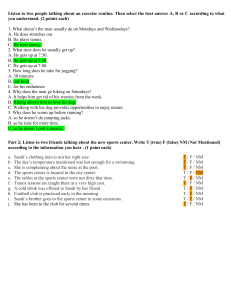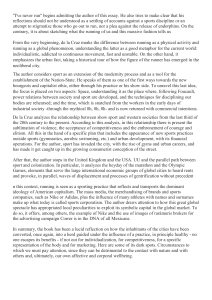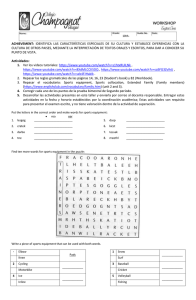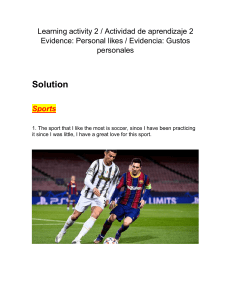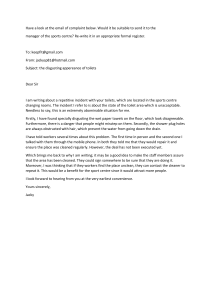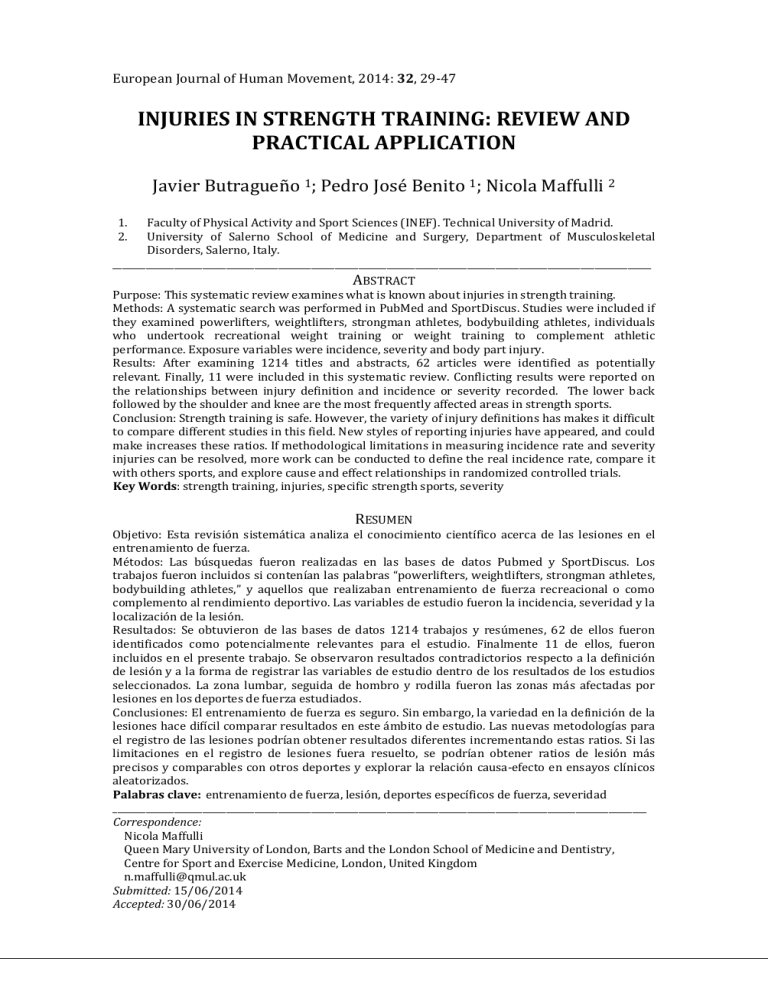
European Journal of Human Movement, 2014: 32, 29-47 INJURIES IN STRENGTH TRAINING: REVIEW AND PRACTICAL APPLICATION 1. 2. Javier Butragueño 1; Pedro José Benito 1; Nicola Maffulli 2 Faculty of Physical Activity and Sport Sciences (INEF). Technical University of Madrid. University of Salerno School of Medicine and Surgery, Department of Musculoskeletal Disorders, Salerno, Italy. __________________________________________________________________________________________________________________ ABSTRACT Purpose: This systematic review examines what is known about injuries in strength training. Methods: A systematic search was performed in PubMed and SportDiscus. Studies were included if they examined powerlifters, weightlifters, strongman athletes, bodybuilding athletes, individuals who undertook recreational weight training or weight training to complement athletic performance. Exposure variables were incidence, severity and body part injury. Results: After examining 1214 titles and abstracts, 62 articles were identified as potentially relevant. Finally, 11 were included in this systematic review. Conflicting results were reported on the relationships between injury definition and incidence or severity recorded. The lower back followed by the shoulder and knee are the most frequently affected areas in strength sports. Conclusion: Strength training is safe. However, the variety of injury definitions has makes it difficult to compare different studies in this field. New styles of reporting injuries have appeared, and could make increases these ratios. If methodological limitations in measuring incidence rate and severity injuries can be resolved, more work can be conducted to define the real incidence rate, compare it with others sports, and explore cause and effect relationships in randomized controlled trials. Key Words: strength training, injuries, specific strength sports, severity RESUMEN Objetivo: Esta revisión sistemática analiza el conocimiento científico acerca de las lesiones en el entrenamiento de fuerza. Métodos: Las búsquedas fueron realizadas en las bases de datos Pubmed y SportDiscus. Los trabajos fueron incluidos si contenían las palabras “powerlifters, weightlifters, strongman athletes, bodybuilding athletes,” y aquellos que realizaban entrenamiento de fuerza recreacional o como complemento al rendimiento deportivo. Las variables de estudio fueron la incidencia, severidad y la localización de la lesión. Resultados: Se obtuvieron de las bases de datos 1214 trabajos y resúmenes, 62 de ellos fueron identificados como potencialmente relevantes para el estudio. Finalmente 11 de ellos, fueron incluidos en el presente trabajo. Se observaron resultados contradictorios respecto a la definición de lesión y a la forma de registrar las variables de estudio dentro de los resultados de los estudios seleccionados. La zona lumbar, seguida de hombro y rodilla fueron las zonas más afectadas por lesiones en los deportes de fuerza estudiados. Conclusiones: El entrenamiento de fuerza es seguro. Sin embargo, la variedad en la definición de la lesiones hace difícil comparar resultados en este ámbito de estudio. Las nuevas metodologías para el registro de las lesiones podrían obtener resultados diferentes incrementando estas ratios. Si las limitaciones en el registro de lesiones fuera resuelto, se podrían obtener ratios de lesión más precisos y comparables con otros deportes y explorar la relación causa-efecto en ensayos clínicos aleatorizados. Palabras clave: entrenamiento de fuerza, lesión, deportes específicos de fuerza, severidad _________________________________________________________________________________________________________________ Correspondence: Nicola Maffulli Queen Mary University of London, Barts and the London School of Medicine and Dentistry, Centre for Sport and Exercise Medicine, London, United Kingdom [email protected] Submitted: 15/06/2014 Accepted: 30/06/2014 Javier Butragueño et al. Injuries in strength training … INTRODUCTION Recently, strength training (weight training or resistance training) (ST) has become an integral part of workout regimens and conditioning for many sportsmen, athletes and other populations (A. D. Faigenbaum et al., 2009; Moinuddin, Collins, Kramer, & Leehey, 2012; Strasser & Schobersberger, 2011; Westcott, 2012). In addition, epidemiological data suggest that participation in ST sport reduced the incidence and mortality associated with cardiovascular disease, diabetes, obesity, hypertension and osteoporosis (Ades, Ballor, Ashikaga, Utton, & Nair, 1996; Ruiz et al., 2008; Strasser & Schobersberger, 2011; Westcott, 2012), and could reduce or prevent the risk of injury during training and competition (A. D. Faigenbaum & Myer, 2010; Leppänen, Aaltonen, Parkkari, Heinonen, & Kujala, 2013; Lloyd et al., 2013). Different authors have emphasized that ST is safe and healthy (Requa, DeAvilla, & Garrick, 1993; Risser, Risser, & Preston, 1990; Westcott, 2012) and showed low incidence rates in youth (0.00017 to 0.29 injuries per 100 hours training) following resistance training, weightlifting and powerlifting (A. D. Faigenbaum & Myer, 2010). However, several epidemiological studies analyzing the National Electronic Injury Surveillance System presented disturbing data in strength sport (Jones, Christensen, & Young, 2000; Kerr, Collins, & Comstock, 2010; Myer, Quatman, Khoury, Wall, & Hewett, 2009; Quatman, Myer, Khoury, Wall, & Hewett, 2009). From 1990 to 2007, they recorded 25335 weight training injuries in US emergency departments and it had estimated 970801 injuries nationwide. Individuals who used free weights had a greater proportion of fractures/dislocations (23.6%; IPR, 2.44; 95% CI: 1.92-3.09; P\.001) than individuals using machines (9.7%)(Kerr et al., 2010). In addition, injury incidence varies between 15-82% among studies in ST (Hak, Hodzovic, & Hickey, 2013; Myer et al., 2009; Weisenthal, Beck, Maloney, DeHaven, & Giordano, 2014; Winwood, Hume, Cronin, & Keogh, 2014) or 0.00017 to 5.5 injuries per 1000 hour of training/competitions (A. D. Faigenbaum & Myer, 2010; Keogh, Hume, & Pearson, 2006; Reynolds et al., 2001). Researchers try to understand how the new styles of specific strength sports such as CrossFit could increase these ratios, and whether they can compare with others studies (Hak et al., 2013; Weisenthal et al., 2014), as studies showed that the injury incidence in ST depends on the quality, content, and intensity of the training program (Kenneth E Powell, Paluch, & Blair, 2011; Risser et al., 1990). Therefore, the epidemiological picture of specific strength sports injuries is still incomplete, with a number of gaps still evident in the relevant literature. To understand the injuries incidence in ST is necessary: A) to recognize different ST populations, category and competition styles to European Journal of Human Movement, 2014: 32, 29-47 30 Javier Butragueño et al. Injuries in strength training … compare studies (powerlifters, weightlifters, strongman, bodybuilding, recreational weight training or complement of athletic performance (Benjamin & Glow, 2003; Carpinelli, 2012; Hamill, 1994; Lavallee & Balam, 2010; Risser, 1990); B) to understand the definition of injury used in each study, because different definitions could lead to different results and conclusions (Best & Shrier, 2007; Keogh et al., 2006; Timpka, Alonso et al., 2014), C) to identify and classify specific injuries using a common injury surveillance system for all types of ST (Brooks & Fuller, 2006; C. F. Finch et al., 2012; Orchard et al., 2010). For these reason, we reviewed the published peer reviewed literature about injury incidence and prevalence in ST, and identify gaps in knowledge about variations in injury definitions, methodologies, and analyses amongst studies. METHOD Search strategy and inclusion criteria The study was performed according to the Preferred Reporting Items for Systematic Review (PRISMA) statement (Moher, Liberati, Tetzlaff, & Altman, 2010). We searched the online databases of PubMed and SPORTDiscus from 1990 through 2014, using search terms suitable to each specific database (Appendix 1). The search strategy to identify studies that met the inclusion criteria consisted of 3 elements (Moher et al., 2010): (1) injury (eg, injury, pain, epidemiology); (2) styles of ST (eg, powerlifters, weightlifters, strongman, crossfit, bodybuilding, recreational weight-training or complement of athletic performance); and (3) type of study (eg, incidence, prevalence, rate, no rehabilitation, no recovery, no prevention) (Figure 1). European Journal of Human Movement, 2014: 32, 29-47 31 Javier Butragueño et al. Injuries in strength training … FIGURE 1: Flow diagram illustrating the number of articles that meet inclusion and exclusion criteria Identified articles were then assessed for the following required inclusion criteria: They had to contain data on ST, and investigate frequency and occurrence injury; studies were prospective, retrospective, observational cohorts, interventions studies or epidemiology studies examining the longitudinal relationship between injuries and some type of ST; the study used a database, survey or a questionnaire to record the injuries occurred during training or competition; the article provided a definition of injuries; the articles was to have been published in English, and studies with powerlifters, weightlifters, bodybuilding, CrossFit, Strongman, recreational weight-training or collegiate Athletic between the ages of 12 to 65 were included. Articles were excluded if no information was provided on injuries during follow up. Case reports, review articles, articles without an abstract were also excluded. Also, other medical problems associated with ST use and literature concerning prevention of ST injury was not included in this review. The exposure variables of interest were injury characteristics including incidence, prevalence, definition and risk factor. Different methods for analyzing or reporting these characteristics were accepted. For instance, European Journal of Human Movement, 2014: 32, 29-47 32 Javier Butragueño et al. Injuries in strength training … incidence could be measured as injuries per 100 hours or 1000 hours, per day, per week, per month or per person. The severity of each injury was defined as “the number of days that have elapsed from the day after the onset of the incident to the day of the athlete’s return to full participation in Athletics training and become fully available for competition”. Severity was reported as minor (1–7 days) which could be subdivided into slight (1 day), minimal (2–3 days), mild (4–7 days), moderately serious (8–28 days), serious (>28 days–6 months) or long-term (>6 months) (Fuller et al., 2006; Timpka, Alonso et al., 2014). Data collection and analysis The bibliographies of the studies identified by the electronic searches were then searched by hand until no further studies were identified. Each study identified as a result of the electronic search was initially evaluated by two reviewers (JB and PJ) by screening the title and abstract. Uncertainties about the eligibility of a particular study were resolved by discussion with PJ, and disagreements were resolved by a third independent reviewer. Data were extracted from the articles independently by two researchers, and then collated. First, a single reviewer checked all titles and abstracts of articles identified through the search process to identify potentially relevant articles. A second reviewer independently screened a 10% random sample. In case of uncertainty, a third reviewer screened the article. Articles without an abstract were excluded. In total, 11 studies fulfilled all inclusion criteria. The first reviewer extracted data from the identified studies, including (1) the study population, (2) the study design, (3) a measure of incidence or prevalence and injuries location, and (4) injury definition. After completing this phase, the reviewers met to attempt to reach a consensus. The consensus process involved each reviewer presenting his observations and results, followed by discussion and debate. A third reviewer was available in cases of persistent disagreement or uncertainty (Hayden, Cote, & Bombardier, 2006; Moher et al., 2010). RESULTS Literature Search The search strategy returned a total of 1214 potentially relevant articles. The results of the database search and subsequent assessment of trials identified are summarized in Figure 1. The systematic literature search yielded 941 publications in PubMed and 273 in SPORTDiscus. After filtering by Academic Journal (n= 1083), excluding articles in animals (n= 197), articles without abstract (n=78) or published European Journal of Human Movement, 2014: 32, 29-47 33 Javier Butragueño et al. Injuries in strength training … before 1990 (n=63), and duplicates (n=152). Finally, we screened 533 articles. Each study identified as a result of the electronic search was initially evaluated independently by two authors (JB and PB) by screening the title and abstract. All articles of interest were retrieved and evaluated for eligibility. The full texts of 62 articles were retrieved and were subsequently evaluated. Articles were excluded if no information was provided on injury definition, injury rates or without information about injury survey o data collection. After this step, 11 articles were identified as potentially relevant and included in the review (Calhoon & Fry, 1999; Hak et al., 2013; Hamill, 1994; Keogh et al., 2006; K.E Powell, Heath, Kresnow, Sacks, & Branche, 1998; Raske & Norlin, 2002; Requa et al., 1993; Risser et al., 1990; Weisenthal et al., 2014; Winwood et al., 2014; Zemper, 1990). Description of studies and injury definition The year of publication for the included studies ranged from 1990 to 2014, and we added one before 1990 for the great relevance to the review. The specific strength sport in this review was show in Table 1. The studies represented populations in USA, Canada, New Zealand, Sweden, Israel, Pennsylvania and United Kingdom. A summary data from each study regarding the demographic characteristics, severity and injury definition as quoted verbatim from the article are presented in Table 2. European Journal of Human Movement, 2014: 32, 29-47 34 Javier Butragueño et al. Category Injuries in strength training … TABLE 1 Description of types of specific strength sports Sport-specific strength sports Category A Weightlifting (a) Category A Strongman (b) Recreational Category B strength (a) training Description The object of this Olympic competition is to lift the maximum weight with the help of a bar in whose ends several discuses are set. There are two types: Snatch and clean and jerk (Hamill, 1994). The term strongman changed to describe one who competes in strength athletics – a more modern eclectic strength competition in which competitors lift rocks, tote refrigerators, pull trains, walk while towing an eighteen wheel truck behind them, etc. The most famous competition of this type is World's Strongest Man and the "World's Strongest Man Super Series", however many countries hold national-level competitions(Winwood et al., 2014). Exercises with gradual load on machines or weight free aimed to improve muscular condition, fitness, power or performance in other sports (Basford, 1985) Sportsmen and women use it in order to improve Category B specific skills such as power, power-endurance or speed Athletic training (b) to enhance their athletic performance (Lavallee & Balam, 2010; Risser, 1990) Crossfit Category C Powerlifting (a) Category C Bodybuilding (b) CrossFit is a conditioning program that its focus in build strength and endurance. It is characterized by workouts that use a wide variety of exercises, ranging from running and rowing to Olympic lifting (snatch, clean, and jerk), power lifting (squat, deadlift, press/push press, bench press), and gymnastic movements (pull-ups, toesto-bar, knees-to-elbows, lunges, muscleups, burpees, dips, gluteus-hamstring developer sit-ups, push-ups, rope climbs, handstand push-ups, pistols (Weisenthal et al., 2014) Competition where three exercises are performed. The maximum weight must be reached in these three different exercises: Squat, bench press and dead lift. This competition is aimed to get the total maximum weight. Participants are classified according to corporal weight (Keogh et al., 2006). The goal in bodybuilding is much less about strength and more about adding size, symmetry, and muscular definition. Bodybuilding is a visual sport, so muscular ‘‘beauty’’ is judged subjectively (Lavallee & Balam, 2010; Reeves, Laskowski, & Smith, 1998) Injury definition used varied considerably between the studies. For instance, Hamill et al (Hamill, 1994) used “Any traumatic act against the body European Journal of Human Movement, 2014: 32, 29-47 35 Javier Butragueño et al. Injuries in strength training … sufficiently serious to have required first aid, filing of school and/or insurance reports, or medical treatment” while Keogh et al (Keogh et al., 2006) used “Any physical damage to the body that caused the lifter to miss or modify one or more training sessions or to miss a competition. We’re not considered injuries unless they were of sufficient magnitude to cause the lifter to miss or modify his or her regular training program or to miss a competition”. And the last selected studies (Hak et al., 2013; Weisenthal et al., 2014; Winwood et al., 2014) used the definition of the recently published consensus injuries (Best & Shrier, 2007; Timpka, Alonso et al., 2014). Injury rates Different units to measure incidence injuries were used. Incidence rates per 1000 participation hour or per 1000 athletic exposure (AE) are shown for elite weight and powerlifters (Calhoon & Fry, 1999; Keogh et al., 2006; Raske & Norlin, 2002), strongman athletes (Winwood et al., 2014) and crossfit training (Hak et al., 2013). Two studies recorded injuries per participant (K.E Powell et al., 1998; Weisenthal et al., 2014). Only one study recorded injuries per 100 participation hours (Hamill, 1994), and two studies reported injuries per person year (Risser, 1990; Winwood et al., 2014). Finally Zemper et al (Zemper, 1990) recorded injuries per 100 Athletes-Exposure. Injury incidence varied from 0.0017-0.0035 injuries per 100 hours in young weight lifters (Hamill, 1994; K.E Powell et al., 1998) to 1.1-7.0 injuries per 1000 hours in powerlifters, weightlifters, strongman athletes, recreational training, crossfit training (Calhoon & Fry, 1999; Hak et al., 2013; Keogh et al., 2006; Raske & Norlin, 2002; Requa et al., 1993; Winwood et al., 2014) or 0.0820.35 injuries per person year or season (Risser et al., 1990; Zemper, 1990). Table 2 presents summary data from each study regarding the injury rate recorded. Injury severity None of the studies used the definition of severity given in this review (Fuller et al., 2006; Timpka, Alonso et al., 2014). Each study recorded severity in a different way. Keog et al (2006) showed that most injuries had a mild (39%) to moderate (39%) effect (severity) on training, meaning that the lifters only had to make relatively minor modifications to the prescribed training program. Only 22% of the injuries were described as having a major effect (i.e., required a complete cessation of training for 1 week or more). The same procedure was used by Winwood et al. (2014), who found 70.6% moderate injuries in strongman athletes. European Journal of Human Movement, 2014: 32, 29-47 36 Javier Butragueño et al. Injuries in strength training … Raske et al (2002) showed that most injuries were major ones (shoulder, low back and Knees), with the duration of symptoms lasting more than 1 month. Calhoon et al. (1999) explain that weightlifting injuries are usually not severe, with 90.5% of the injuries resulting in less than 1 day of training missed. Risser et al (1990) recorded that 24 (88.9%) of 27 injuries were of moderate severity; 3 (11.1%) of 27 injuries were major and none were severe. Powell et al (1998) explain that for weightlifting and aerobics, nearly everyone who reported an injury reduced their level of participation, and 25-30% sought medical care or missed one half day or more of works, housework or school. Hak et al (2013) reported that nine participants (7.0%) had sustained an injury that required surgical intervention. Some studies included did not record the severity of the injury (Hamill, 1994). Injury Location Seven of 11 studies showed a preponderance of injuries of the lower back (24-48%)(Calhoon & Fry, 1999; Raske & Norlin, 2002; Risser et al., 1990; Winwood et al., 2014; Zemper, 1990), shoulder (25-50%) (Hak et al., 2013; Keogh et al., 2006; Raske & Norlin, 2002; Weisenthal et al., 2014) and knees (11-21%) (Calhoon & Fry, 1999; Hak et al., 2013; Winwood et al., 2014) among studies depending on the specific training (table 2). Some studies did not report or record injury location (Hamill, 1994; K.E Powell et al., 1998) DISCUSSION Our review yielded three clinically relevant findings. First, most studies show variation in the definition of injury, methodologies, and analyses, which can lead to differences in results and conclusions obtained. Second, incidence and prevalence rate depend on definition and type of strength sports. Finally, lower back followed by shoulders and knees are most frequently injuries in ST. In epidemiological sports injury research it is especially important to distinguish between different types of specific strength sports and use a common injury surveillance system (Best & Shrier, 2007; C. F. Finch & Cook, 2013; C. F. Finch et al., 2012; Timpka, Alonso et al., 2014). However, few studies in strength training use this consensus or data collection procedures. Injury Rates Different common ways to report injuries in epidemiological studies have been used (Brooks & Fuller, 2006). It is correct to use the incidence (injury per time) for comparison purposes (Fuller et al., 2006; Timpka, Alonso et al., 2014; Timpka, Jacobsson et al., 2014) because the risk of injury must be related to the European Journal of Human Movement, 2014: 32, 29-47 37 Javier Butragueño et al. Injuries in strength training … time spent engaged in training or competition, and they propose to calculate the number of injures per 1000 participation hour or per 1000 athletic exposure (AE) to unify criteria in sports injuries (Best & Shrier, 2007). On the other hand, Brooks et al.(2006) explain that it is convenient to separate and record the injury during training or competition, because the results depend on the ratio of training to match/competition exposure. However, only 5 studies in this review used this methodology to report injuries (Calhoon & Fry, 1999; Hak et al., 2013; Keogh et al., 2006; Raske & Norlin, 2002; Winwood et al., 2014), and not all studies have considered whether injuries occur during training or competition. Calhoon et al (1999) considered that the athletes monitored in their study did not show a greater risk of injury than other sports. In fact, several studies have claimed that the injury rates in strength sports are lower than other sports (A. D. Faigenbaum et al., 2009; Hamill, 1994; Lubetzky-Vilnai, Carmeli, & Katz-Leurer, 2009; Nicholl, Coleman, & Williams, 1995; Risser et al., 1990), but recent articles have shown that the incidence rate (2.7-5.5 injuries per 1000 hour) (Keogh et al., 2006; Raske & Norlin, 2002; Winwood et al., 2014) could be similar to team sports such as volleyball (4.1 injuries per 1000 hour), hockey (2.5 injuries per 1000 hour) or baseball (1.9 injuries per 1000 hour) (Hootman, Dick, & Agel, 2007) when the same reporting system was used. However, these rates are still lower compared with National Football League competition (12.7 injuries per 1000 AE) (Feeley et al., 2008). Furthermore, new styles of specifics strength training as the CrossFit continues to expand and injuries associated with involvement will likely grow (Hak et al., 2013; Weisenthal et al., 2014). The highest injury rates were definitely related to the injury definition (Keogh et al., 2006; Nicholl et al., 1995; Winwood et al., 2014) ‘‘any medical problem that required physical or medical assistance and ‘‘any consultation and/or treatment given to a player during a tournament on site’’, respectively. According to different authors, injury incidence is highly dependent on the definitions of 'sports injury' and “sports participation” (C. Finch, 2006; Van Mechelen, Hlobil, & Kemper, 1992), and it also depends on external or internal risk factor such as the quality, content, and intensity of the training program (Bahr & Krosshaug, 2005). Faigenbaum and Myer (2010) compared injury patterns among different studies, but did not take into account the different injury definitions or style of specific strength sports. A similar problem exists in the articles included in this systematic review. Lavallee et al. (2010) explain that, when evaluating those injured in strength training, it is imperative to know which of the many disciplines of strength sport the athlete is involved in, his or her age, and the duration of involvement in the sport, and the use of ergogenic aids or certain antibiotics, as well as the acute or chronic nature of European Journal of Human Movement, 2014: 32, 29-47 38 Javier Butragueño et al. Injuries in strength training … the athlete’s injury. Not all studies describe as recorded type of ST, hours of exposure, type of training or the definition of injury. In this review, Winwood et al (2014) used a standardized definition developed in others sports (Fuller et al., 2006; Timpka, Alonso et al., 2014; Timpka, Jacobsson et al., 2014) and can ultimately assist in injury prevention. Severity injury Two key parameters in an epidemiological study are injury incidence and severity (Brooks & Fuller, 2006; Van Mechelen et al., 1992). Severity is determined by the number of days of absence or modification from training or competition participation (Fuller et al., 2006; Timpka, Alonso et al., 2014). The results obtained are all different from each other, and only Keogh et al and Winwood et al used the same methods (Keogh et al., 2006; Winwood et al., 2014). They reported a 20-22% incidence of injuries as major (i.e., required a complete cessation of training for a week or more), and that strongman athletes suffered less mild (33%) and more moderate injuries (47%) than powerlifters. However, we cannot compare with others studies, because the latter did not use the same criteria. Despite their importance, injury definition and methods of calculating severity makes it very difficult or impossible to compare the studies included in this systematic review. The literature showed conflicting results with regard to severity injury because of the way of assessing injuries. For example, studies in CrossFit that used powerlifting movement suggests that the majority of injuries in CrossFit are minor and return to participation is likely. However, reporting was measured subjectively and this may be a major problem (Hak et al., 2013; Weisenthal et al., 2014). Data from the National Electronic Injury Surveillance System (NEISS) examining weight training-related injuries between from 1990 to 2007 (Jones et al., 2000; Kerr et al., 2010) showed 25335 weight trainingrelated injuries which correlate to an estimated 970801 injuries nationwide. However, NEISS study limitations are also associated with the dataset, which provides limited information about the circumstances of injury. Only injuries treated in EDs are captured, excluding less severe injuries that may have not received any medical attention or that may have been treated in other health care settings. On the other hand, NEISS data contain only the most severe injury for each person, and do not include any follow-up information regarding length of injury time or experience level with weight training (Bahr, 2009; Brooks & Fuller, 2006; Timpka, Alonso et al., 2014). One possible solution is to standardize the definition of severity of injury (Brooks & Fuller, 2006; Timpka, Alonso et al., 2014). The day when an injury occurs does not count toward determining injury severity; the assessment of severity (days lost) starts on the European Journal of Human Movement, 2014: 32, 29-47 39 Javier Butragueño et al. Injuries in strength training … following day if the athlete is unable to take part in full and/or normal training and/or competition. Severity should be reported as minor (1–7 days) which could be subdivided into slight (1 day), minimal (2–3 days), mild (4–7 days), and moderately serious (8–28 days), serious (>28 days–6 months) or long-term (>6 months) (Timpka, Alonso et al., 2014). Location Based on the studies reviewed, the most frequently injured body regions in specific strength sports were lower back (Calhoon & Fry, 1999; Mundt et al., 1993; Risser, 1991; Weisenthal et al., 2014; Winwood et al., 2014; Zemper, 1990), shoulder (Keogh et al., 2006; Raske & Norlin, 2002; Weisenthal et al., 2014; Winwood et al., 2014) and knees (Calhoon & Fry, 1999; Reynolds et al., 2001; Weisenthal et al., 2014). Body injury location and some types of injuries are seen uniquely in one particular type of strength sports. For example, CrossFit routines incorporate high-intensity interval training, olympic weightlifting, plyometrics, powerlifting, gymnastics, kettlebell training, calisthenics, strongman exercises and other exercises (Hak et al., 2013; Weisenthal et al., 2014), and we can observe different injury locations depending on the exercise performed. Weisenthal, et al (Weisenthal et al., 2014) showed that shoulders (10.5%), knees (21.1%), and low back (47.4%) are most frequent in powerlifting, but Olympic weight lifting athletes suffer more shoulder (28%), upper back (1.5%) and neck injuries (14.3%). Normally, powerlifters, weightlifter, strongman or CrossFit training requires explosive strength of the shoulder, pectorals, triceps, legs, and hips, as well as stabilization of each of the various joints (Colado & Garcia-Masso, 2009; Harbili & Alptekin, 2014; Lavallee & Balam, 2010; Winwood et al., 2014). When training close to the 1 RM, the rotator cuff and its bursa are compressed against the acromion when the arms are completely flexed. Therefore, subacromial impingement syndrome is triggered (Gross, Brenner, Esformes, & Sonzogni, 1993; Haupt, 2001). Furthermore, abduction and external rotation of the shoulder put the rotators cuff tendonsto the shoulder capsule and the glenohumeral inferior ligament at risk (Cresswell & Smith, 1998; Esenkaya, Tuygun, & Tuerkmen, 2000; Harman, 1994; Maffulli & Mikhail, 1990). Power exercises carried out during strength training put the body in ‘at risk’ positions (Hak et al., 2013; Keogh et al., 2006; Weisenthal et al., 2014; Winwood et al., 2014), as the upper and lower body, all joints and muscles of the knee, hips and shoulders are involved in these exercises. During these exercises, the L5/S1 vertebral segments are vulnerable mainly because an overhead lift is carried out. In some studies, power exercises such as the snatch and clean and jerk European Journal of Human Movement, 2014: 32, 29-47 40 Javier Butragueño et al. Injuries in strength training … were the main factors which can trigger atraumatic clavicle osteolysis, radial and ulna fractures and low back problems (Gumbs, Segal, Halligan, & Lower, 1982; Rossi & Dragoni, 1990; Scavenius & Iversen, 1992). However, Munt et al (1993) claimed that there are no association between the use of free weights and lumbar herniation. It was not however possible to identify which training errors are related to ST related injuries. Analysis of strength training is complex, since one or more training variables may interact with other training variables. However, the general nature of weight training injuries is quite similar among all those who train with weights, who are more likely to suffer from traumatic and chronic injuries because of various erroneous habits or poor technique (Hooper et al., 2014; Jones et al., 2000; Kerr et al., 2010; Weisenthal et al., 2014; Winwood et al., 2014). For these reason, neuromuscular training should be included in training programs, because it could reduce knee, shoulder, and low back injuries in adolescents and novice athletes in ST (Avery D Faigenbaum et al., 2014; Stevenson, Beattie, Schwartz, & Busconi, 2014). Future research should be aimed at using a specific classification and terminology to ease the communication between researchers. The best classification is one in which professionals in the sport and experts in sports medicine are involved. For these reason, the Orchard Sports Injury Classification System (OSICS-10) complies with these requisites (C. F. Finch et al., 2012; Hammond, Lilley, & Ribbans, 2008; Orchard et al., 2010; Rae & Orchard, 2007). In addition, emergent injuries are uncommon in strength sports, but those sports medicine physicians who choose to cover these events should be prepared for them. Limitations Although we used a broad search strategy over several electronic databases and scanned the bibliographies of included papers, we may have missed some articles. To maximize efficiency, we used a second reviewer to validate all data extraction rather than rely on independent data abstraction. Finally, we limited our study to English language publications, and we would have missed articles in other languages. CONCLUSIONS A standardized definition of injury would benefit the understanding of injury prevalence, and can ultimately assist in injury prevention (Van Mechelen et al., 1992). Additionally, Best et al (2007) and Gabbe et al (2003) question the validity and reliability of measuring injury by self-reporting, as this method may be affected by subject recall bias. This review indicates that defining injury in specific strength sports is fundamental in the field of epidemiological and European Journal of Human Movement, 2014: 32, 29-47 41 Javier Butragueño et al. Injuries in strength training … injury prevention. Although it would be desirable to reach a consensus, few well-conducted studies are available, making results inconclusive. REFERENCES Ades, P. A., Ballor, D. L., Ashikaga, T., Utton, J. L., & Nair, K. S. (1996). Weight training improves walking endurance in healthy elderly persons. Ann Intern Med, 124(6), 568-572. Bahr, R. (2009). No injuries, but plenty of pain? On the methodology for recording overuse symptoms in sports. Br J Sports Med, 43(13), 966-972. doi:43/13/966 [pii]10.1136/bjsm.2009.066936 Bahr, R., & Krosshaug, T. (2005). Understanding injury mechanisms: a key component of preventing injuries in sport. Br J Sports Med, 39(6), 324-329. Basford, J. R. (1985). Weightlifting, weight training and injuries. Orthopedics, 8(8), 1051-1056. Benjamin, H. J., & Glow, K. M. (2003). Strength training for children and adolescents: what can physicians recommend? Phys Sportsmed, 31(9), 19-26. doi: 10.3810/psm.2003.09.482 Best, T. M., & Shrier, I. (2007). From study design and analysis to conclusion: new horizons for epidemiological rigor in sport medicine. Clin J Sport Med, 17(3), 175-176. doi: 10.1097/JSM.0b013e318061b75d Brooks, J. H., & Fuller, C. W. (2006). The influence of methodological issues on the results and conclusions from epidemiological studies of sports injuries. Sports medicine, 36(6), 459-472. Calhoon, G., & Fry, A. C. (1999). Injury Rates and Profiles of Elite Competitive Weightlifters. J Athl Train, 34(3), 232-238. Carpinelli, R. N. (2012). Critical commentary: the NSCA position statement on youth resistance training. Medicina Sportiva, 16(1), 46-50. Colado, J. C., & Garcia-Masso, X. (2009). Technique and safety aspects of resistance exercises: a systematic review of the literature. Phys Sportsmed, 37(2), 104-111. doi: 10.3810/psm.2009.06.1716 Cresswell, T. R., & Smith, R. B. (1998). Bilateral anterior shoulder dislocations in bench pressing: an unusual cause. Br J Sports Med, 32(1), 71-72. Esenkaya, I., Tuygun, H., & Tuerkmen, I. M. (2000). Bilateral anterior shoulder dislocation in a weight lifter. The Physician and sportsmedicine, 28(3). Faigenbaum, A. D., Kraemer, W. J., Blimkie, C. J., Jeffreys, I., Micheli, L. J., Nitka, M. (2009). Youth resistance training: updated position statement paper from the national strength and conditioning association. J Strength Cond Res, 23(5 Suppl), S60-79. doi: 10.1519/JSC.0b013e31819df407 [doi] European Journal of Human Movement, 2014: 32, 29-47 42 Javier Butragueño et al. Injuries in strength training … Faigenbaum, A. D., & Myer, G. D. (2010). Resistance training among young athletes: safety, efficacy and injury prevention effects. Br J Sports Med, 44(1), 56-63. doi: bjsm.2009.068098 [pii] 10.1136/bjsm.2009.068098 Faigenbaum, A. D., Myer, G. D., Farrell, A., Radler, T., Fabiano, M., Kang, J. (2014). Integrative Neuromuscular Training and Sex-Specific Fitness Performance in 7-Year-Old Children: An Exploratory Investigation. Journal of athletic training, 49(2). Feeley, B. T., Kennelly, S., Barnes, R. P., Muller, M. S., Kelly, B. T., Rodeo, S. A. (2008). Epidemiology of National Football League training camp injuries from 1998 to 2007. The American journal of sports medicine, 36(8), 15971603. Finch, C. (2006). A new framework for research leading to sports injury prevention. J Sci Med Sport, 9(1-2), 3-9; discussion 10. doi: S14402440(06)00023-5 [pii]10.1016/j.jsams.2006.02.009 Finch, C. F., & Cook, J. (2013). Categorising sports injuries in epidemiological studies: the subsequent injury categorisation (SIC) model to address multiple, recurrent and exacerbation of injuries. British Journal of Sports Medicine. Finch, C. F., Orchard, J. W., Twomey, D. M., Saleem, M. S., Ekegren, C. L., Lloyd, D. G. (2012). Coding OSICS sports injury diagnoses in epidemiological studies: does the background of the coder matter? British Journal of Sports Medicine. Fuller, C. W., Ekstrand, J., Junge, A., Andersen, T. E., Bahr, R., Dvorak, J. (2006). Consensus statement on injury definitions and data collection procedures in studies of football (soccer) injuries. Clin J Sport Med, 16(2), 97-106. doi: 00042752-200603000-00003 [pii] Gabbe, B. J., Finch, C. F., Bennell, K. L., & Wajswelner, H. (2003). How valid is a self reported 12 month sports injury history? Br J Sports Med, 37(6), 545547. Gross, M. L., Brenner, S. L., Esformes, I., & Sonzogni, J. J. (1993). Anterior shoulder instability in weight lifters. Am J Sports Med, 21(4), 599-603. Gumbs, V. L., Segal, D., Halligan, J. B., & Lower, G. (1982). Bilateral distal radius and ulnar fractures in adolescent weight lifters. Am J Sports Med, 10(6), 375379. Hak, P. T., Hodzovic, E., & Hickey, B. (2013). The nature and prevalence of injury during CrossFit training. Journal of strength and conditioning research/National Strength & Conditioning Association. Hamill, B. P. (1994). Relative safety of weightlifting and weight training. J Strength Cond Res, 8(1), 53-57. European Journal of Human Movement, 2014: 32, 29-47 43 Javier Butragueño et al. Injuries in strength training … Hammond, L. E., Lilley, J., & Ribbans, W. J. (2008). Coding Sports Injury Surveillance Data: Has Version 10 of the Orchard Sports Injury Classification System improved the classification of sports medicine diagnoses? Br J Sports Med. doi: bjsm.2008.051979 [pii]10.1136/bjsm.2008.051979 Harbili, E., & Alptekin, A. (2014). Comparative Kinematic Analysis of the Snatch Lifts in Elite Male Adolescent Weightlifters. Journal of sports science & medicine, 13(2), 417. Harman, E. (1994). Weight training safety: a biomechanical perspective. Strength and Conditioning. Haupt, H. A. (2001). Upper extremity injuries associated with strength training. Clin Sports Med, 20(3), 481-490. Hayden, J. A., Cote, P., & Bombardier, C. (2006). Evaluation of the quality of prognosis studies in systematic reviews. Ann Intern Med, 144(6), 427-437. doi: 144/6/427 [pii] Hooper, D. R., Szivak, T. K., Comstock, B. A., Dunn-Lewis, C., Apicella, J. M., Kelly, N. A. (2014). Effects of Fatigue From Resistance Training on Barbell Back Squat Biomechanics. The Journal of Strength & Conditioning Research, 28(4), 1127-1134. Hootman, J. M., Dick, R., & Agel, J. (2007). Epidemiology of collegiate injuries for 15 sports: summary and recommendations for injury prevention initiatives. J Athl Train, 42(2), 311-319. Jones, C. S., Christensen, C., & Young, M. (2000). Weight training injury trends: a 20-year survey. The Physician and sportsmedicine, 28(7). Keogh, J., Hume, P. A., & Pearson, S. (2006). Retrospective injury epidemiology of one hundred one competitive Oceania power lifters: the effects of age, body mass, competitive standard, and gender. J Strength Cond Res, 20(3), 672-681. doi: R-18325 [pii]10.1519/R-18325.1 Kerr, Z. Y., Collins, C. L., & Comstock, R. D. (2010). Epidemiology of weight training-related injuries presenting to United States emergency departments, 1990 to 2007. Am J Sports Med, 38(4), 765-771. doi: 0363546509351560 [pii]10.1177/0363546509351560 Lavallee, M. E., & Balam, T. (2010). An overview of strength training injuries: acute and chronic. Curr Sports Med Rep, 9(5), 307-313. doi: 10.1249/JSR.0b013e3181f3ed6d Leppänen, M., Aaltonen, S., Parkkari, J., Heinonen, A., & Kujala, U. M. (2013). Interventions to prevent sports related injuries: A systematic review and meta-analysis of randomised controlled trials. Sports medicine, 1-14. Lubetzky-Vilnai, A., Carmeli, E., & Katz-Leurer, M. (2009). Prevalence of injuries among young adults in sport centers: relation to the type and pattern of European Journal of Human Movement, 2014: 32, 29-47 44 Javier Butragueño et al. Injuries in strength training … activity. Scand J Med Sci Sports, 19(6), 828-833. doi: SMS854 [pii]10.1111/j.1600-0838.2008.00854.x Lloyd, R. S., Faigenbaum, A. D., Stone, M. H., Oliver, J. L., Jeffreys, I., Moody, J. A. (2013). Position statement on youth resistance training: the 2014 International Consensus. British Journal of Sports Medicine, bjsports-2013092952. Maffulli, N., & Mikhail, H. M. (1990). Bilateral anterior glenohumeral dislocation in a weight lifter. Injury, 21(4), 254-256. Moher, D., Liberati, A., Tetzlaff, J., & Altman, D. G. (2010). Preferred reporting items for systematic reviews and meta-analyses: the PRISMA statement. Int J Surg, 8(5), 336-341. doi: S1743-9191(10)00040-3 [pii]10.1016/j.ijsu.2010.02.007 Moinuddin, I., Collins, E., Kramer, H., & Leehey, D. (2012). Exercise in the management of obesity. J Obes Weig Los Ther, 2, 117. Mundt, D. J., Kelsey, J. L., Golden, A. L., Panjabi, M. M., Pastides, H., Berg, A. T. (1993). An epidemiologic study of sports and weight lifting as possible risk factors for herniated lumbar and cervical discs. The Northeast Collaborative Group on Low Back Pain. Am J Sports Med, 21(6), 854-860. Myer, G. D., Quatman, C. E., Khoury, J., Wall, E. J., & Hewett, T. E. (2009). Youth versus adult "weightlifting" injuries presenting to United States emergency rooms: accidental versus nonaccidental injury mechanisms. J Strength Cond Res, 23(7), 2054-2060. doi: 10.1519/JSC.0b013e3181b86712 [doi]00124278-200910000-00020 [pii] Nicholl, J. P., Coleman, P., & Williams, B. T. (1995). The epidemiology of sports and exercise related injury in the United Kingdom. British Journal of Sports Medicine, 29(4), 232-238. Orchard, J., Rae, K., Brooks, J., Hägglund, M., Til, L., Wales, D. (2010). Revision, uptake and coding issues related to the open access Orchard Sports Injury Classification System (OSICS) versions 8, 9 and 10.1. Open access journal of sports medicine, 1, 207. Powell, K. E., Heath, G. W., Kresnow, M. J., Sacks, J. J., & Branche, C. M. (1998). Injury rates from walking, gardening, weightlifting, outdoor bicycling, aerobics. Medicine and science in sports and exercise, 30(8), 1246-1249. Powell, K. E., Paluch, A. E., & Blair, S. N. (2011). Physical activity for health: What kind? How much? How intense? On top of what? Public Health, 32(1), 349. Quatman, C. E., Myer, G. D., Khoury, J., Wall, E. J., & Hewett, T. E. (2009). Sex differences in "weightlifting" injuries presenting to United States emergency rooms. J Strength Cond Res, 23(7), 2061-2067. doi: 10.1519/JSC.0b013e3181b86cb9 [doi] 00124278-200910000-00021 [pii] European Journal of Human Movement, 2014: 32, 29-47 45 Javier Butragueño et al. Injuries in strength training … Rae, K., & Orchard, J. (2007). The Orchard Sports Injury Classification System (OSICS) version 10. Clin J Sport Med, 17(3), 201-204. doi: 10.1097/JSM.0b013e318059b53600042752-200705000-00007 [pii] Raske, A., & Norlin, R. (2002). Injury incidence and prevalence among elite weight and power lifters. Am J Sports Med, 30(2), 248-256. Reeves, R. K., Laskowski, E. R., & Smith, J. (1998). Weight training injuries. Part 1: diagnosing and managing acute conditions. Physician and sportsmedicine, 26(2), 67-71;74-75;79-80;83;96. Requa, R. K., DeAvilla, L. N., & Garrick, J. G. (1993). Injuries in recreational adult fitness activities. Am J Sports Med, 21(3), 461-467. Reynolds, K. L., Harman, E. A., Worsham, R. E., Sykes, M. B., Frykman, P. N., & Backus, V. L. (2001). Injuries in women associated with a periodized strength training and running program. J Strength Cond Res, 15(1), 136-143. Risser, W. L. (1990). Musculoskeletal injuries caused by weight training. Guidelines for prevention. Clin Pediatr (Phila), 29(6), 305-310. Risser, W. L. (1991). Weight-training injuries in children and adolescents. Am Fam Physician, 44(6), 2104-2108. Risser, W. L., Risser, J. M., & Preston, D. (1990). Weight-training injuries in adolescents. Am J Dis Child, 144(9), 1015-1017. Rossi, F., & Dragoni, S. (1990). Lumbar spondylolysis: occurrence in competitive athletes. Updated achievements in a series of 390 cases. J Sports Med Phys Fitness, 30(4), 450-452. Ruiz, J. R., Sui, X., Lobelo, F., Morrow, J. R., Jr., Jackson, A. W., Sjostrom, M. (2008). Association between muscular strength and mortality in men: prospective cohort study. BMJ, 337, a439. Scavenius, M., & Iversen, B. F. (1992). Nontraumatic clavicular osteolysis in weight lifters. Am J Sports Med, 20(4), 463-467. Stevenson, J. H., Beattie, C. S., Schwartz, J. B., & Busconi, B. D. (2014). Assessing the Effectiveness of Neuromuscular Training Programs in Reducing the Incidence of Anterior Cruciate Ligament Injuries in Female Athletes A Systematic Review. The American journal of sports medicine, 0363546514523388. Strasser, B., & Schobersberger, W. (2011). Evidence for resistance training as a treatment therapy in obesity. J Obes, 2011. doi: 10.1155/2011/482564 Timpka, T., Alonso, J.-M., Jacobsson, J., Junge, A., Branco, P., Clarsen, B. (2014). Injury and illness definitions and data collection procedures for use in epidemiological studies in Athletics (track and field): Consensus statement. British Journal of Sports Medicine, 48(7), 483-490. Timpka, T., Jacobsson, J., Bickenbach, J., Finch, C. F., Ekberg, J., & Nordenfelt, L. (2014). What is a sports injury? Sports medicine, 1-6. European Journal of Human Movement, 2014: 32, 29-47 46 Javier Butragueño et al. Injuries in strength training … Van Mechelen, W., Hlobil, H., & Kemper, H. C. (1992). Incidence, severity, aetiology and prevention of sports injuries. A review of concepts. Sports Med, 14(2), 82-99. Weisenthal, B. M., Beck, C. A., Maloney, M. D., DeHaven, K. E., & Giordano, B. D. (2014). Injury Rate and Patterns Among CrossFit Athletes. Orthopaedic Journal of Sports Medicine, 2(4), 2325967114531177. Westcott, W. L. (2012). Resistance Training is Medicine: Effects of Strength Training on Health. Curr Sports Med Rep, 11(4), 209-216. doi: 10.1249/JSR.0b013e31825dabb8 Winwood, P. W., Hume, P. A., Cronin, J. B., & Keogh, J. W. (2014). Retrospective Injury Epidemiology of Strongman Athletes. The Journal of Strength & Conditioning Research, 28(1), 28-42. Zemper, E. D. (1990). Four-year study of weightroom injuries in a national sample of college football teams. National Strength and Conditioning Association Journal, 12(3), 32-34. APPENDIX 1: SEARCH TERMS PubMed (((injur*[Title/Abstract]) OR pain[Title/Abstract]) OR epidemiolog*[Title/Abstract]) AND ((((((((((((bodybuild*[Title/Abstract]) OR CrossFit [Title/Abstract]) OR Strongman [Title/Abstract]) OR "resistance exercise"[Title/Abstract]) OR "strength training"[Title/Abstract]) OR weight-training[Title/Abstract]) OR "weight training"[Title/Abstract]) OR powerlift*[Title/Abstract]) OR “power lifters”[Title/Abstract]) OR "resistance training"[Title/Abstract]) OR “weight lifting”[Title/Abstract]) OR “weightlift*”[Title/Abstract]) NOT (rehabilitation[Title/Abstract]) NOT (recovery[Title/Abstract]) SportDISCUS TI injury AND ( AB Weight training OR AB powerlifters OR AB powerlifting OR AB CrossFit OR AB resistance training OR AB Weight lifting OR AB Weightlifter OR AB bodybuilder OR AB bodybuilding OR AB Strength training NOT AB Recovery NOT AB rehabilitation ) European Journal of Human Movement, 2014: 32, 29-47 47

